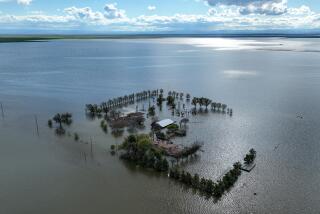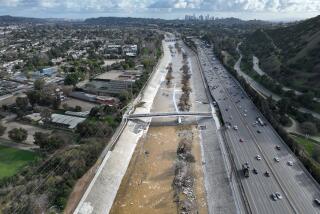1938 Flood: A Watershed for the County
It was just past midnight on March 3, 1938, when Edna Wisser gingerly walked into her daughter’s bedroom to wake her up, and to show her what nature looks like on a bender.
“Mother woke me up sometime in the darkness of the night,” said Marion Harvey, now 78, an Anaheim High senior at the time. “Very calmly, she said: ‘I want you to look outside your bedroom window, because something is happening that you will never see again.’ ”
She was right.
In what remains Orange County’s worst natural disaster, the Santa Ana River, bloated by five days of rain, roared past its banks. An 8-foot wall of water toppled bridges and uprooted railroad tracks, tossing about barns and cars like bathtub toys. More than 50 people died, including 43 at a Mexican settlement in Atwood. An Anaheim mother was found dead a mile from her home, her baby still nestled in her arms.
That night was a turning point for Orange County, part of the most vulnerable flood plain west of the Mississippi River. In its aftermath, the government launched an epic, $1.3-billion campaign to conquer the mighty Santa Ana. On Thursday, the county officially became safe ground.
The U.S. Army Corps of Engineers ruled that Orange County’s share of the Santa Ana flood basin is now protected from a “100-year flood”--a flood that’s so big, it will hit only once per century, on average.
The decision, which must be affirmed by the Federal Emergency Management Agency, means 30,000 homeowners and more than 10,000 business owners won’t have to pay mandatory flood insurance starting next year. Collectively, the county will save more than $1 million a month in insurance premiums, and similar reductions could be granted in Riverside and San Bernardino counties in years to come.
“I’m surprised at the decision,” said Harvey, who still carries vivid memories of baseball gloves, track shoes and shotgun shells ruined in the flooded basement of her family’s downtown Anaheim sporting goods store in 1938. “But I feel very comfortable now. I feel very safe.”
It is, to a degree, a tale of money. Thursday’s decision was the fruit of a 60-year, $1.3-billion campaign to protect Orange County. As of February 1998, there were 380,524 flood insurance policies in California, and premiums total $149.8 million each year.
It’s a tale of bricks and engineering. The new Seven Oaks Dam, the primary development that prompted the ruling, is 550 feet high, as high as the Washington Monument, and contains 43 million cubic yards of clay and rock.
But more than anything else, it’s a tale of man battling nature, overcoming the threat of a river that reigned over Orange County for centuries, that dictated what could be built, where it could be built and when it could be built.
London has its river Thames; Orange County has its river tamed. It’s a good thing: If the county wasn’t protected and the 1938 flood hit today, government officials estimate that 3,000 people would die and damage would top $25 billion. More than 110,000 acres would be flooded with 3 feet of water, and 255,000 structures would be damaged.
“It is a great achievement,” said A.B. Mehta, a senior engineer with Orange County’s flood program section. “The threat of flooding from the Santa Ana River has been mitigated.”
A Catalyst for Change
The 1938 flood, though a monster, wasn’t an isolated event.
In 1912, a lake settled in over the foothills of the Santa Ana Mountains, marooning Fullerton and Tustin. In March 1983, 7-foot waves toppled half of the Seal Beach Pier. Just seven years ago, a police officer detouring drivers around a flooded intersection scooped up a 35-pound carp that was swimming down Irvine Boulevard.
But 1938 was a catalyst that would eventually change Orange County’s way of life.
Three years later, the government built Prado Dam in Riverside County.
That offered enough protection to launch the development of modern Orange County. But a building boom in the ‘50s and ‘60s increased the threat of urban runoff--which contributes to the threat of floods--and made the area vulnerable again.
“Before that, the flooding would damage mostly agricultural areas,” said Herbert I. Nakasone, the manager of Orange County’s flood control planning. “But with the growth of Orange County, the overflow threatened people’s lives and dwellings. The potential damage increased considerably.”
That prompted the construction of the $250-million Seven Oaks Dam in San Bernardino County. Its gates have never been closed, but with the Army Corps’ declaration, officials now have the authority to close them if it rains heavily. The completion of the second dam, along with an extensive widening of the river from Wier Canyon Road to the ocean, led to the government’s ruling that Orange County is once again safe from a once-in-a-century flood.
“They have made great progress,” said Mike Shore, a FEMA flood program specialist in San Francisco. “Taking these steps ahead of time to prevent the damage, or at least minimize the damage, goes a long way in terms of saving taxpayers’ money.”
Government engineers, however, aren’t granting themselves much time for celebration because the flood-control campaign in Orange County isn’t complete--not by a longshot.
First, environmental groups filed a lawsuit in March seeking to protect the endangered San Bernardino kangaroo rat, whose habitat lies in front of the Seven Oaks Dam. The rats, as well as two endangered plants, the Santa Ana River woolly star and the slender-horned spineflower, rely on open, sandy areas that flood regularly.
The suit, which already postponed the launch of the massive dam, remains unresolved and potentially could render Thursday’s decision moot.
But that’s unlikely, officials said. The government agencies involved in the river project are negotiating with court officials and environmental advocates to resolve the concerns over the kangaroo rat. Government officials probably will be forced to construct new habitat for the rats to resolve the legal tangle, Nakasone said.
Second, there are more than 20 channels and small creeks in Orange County--many of which serve as the infrastructure for the Santa Ana River flood control system--that are no longer adequate themselves, engineers said.
More Work Ahead
County officials are now investigating the most critical watersheds, such as the Talbert Valley and Huntington Beach channels. Many of them will be widened or deepened in coming years, said Ray Lenaburg, a senior engineer with FEMA in San Francisco.
But the county still needs to find the tens of millions of dollars to make channel improvements. The task was made harder by the county’s 1994 bankruptcy, which left officials with less money for flood control upgrades.
Finally, the federal government is planning to spend hundreds of millions of dollars raising the walls of the Prado Dam in Riverside County, increasing its storage capacity by at least 50%. That project is critical to continuing to protect Orange County, and to combating explosive growth in Riverside and San Bernardino counties.
Without that project--its funding has always been shaky--the Army Corps’ ruling could be reversed and mandatory insurance could be levied again. That happened last year in southeast Los Angeles County, where thousands of homeowners were forced to buy insurance after the government decided the Los Angeles River and its tributaries no longer protected the region.
“We do have 100-year protection for the Santa Ana River downstream in Orange County,” Lenaburg said. “But they need to raise Prado. If they don’t, we could be back to square one.”
Despite the grand Santa Ana River campaign, many believe that’s a very real possibility.
“There has been a lot of housing, and there has been a lot of commercial and industrial building that has gone on in what I would consider questionably safe areas,” said Doug Renner, 49, whose family’s downtown Anaheim department store, the SQR Store, was buried in muck after the 1938 flood.
“We rely on experts to evaluate it. But I question anyone’s ability to say that we are safe from something like this.”
(BEGIN TEXT OF INFOBOX / INFOGRAPHIC)
The History
Some of the more notable floods in Orange County include:
1825: Flood on the Santa Ana River said to have created Balboa Island in Newport Beach
1862: Considered the area’s worst-recorded flood; most of county covered by at least 3 feet of water
1914: Santa Ana River overflow submerges nearly all of Newport Beach; row boats used to get around
1916: Four die in massive flooding that washes out most roads and rail lines, leaving Orange, Fullerton and Tustin marooned
1938: Fifty-eight people killed, portions of downtown Garden Grove, Santa Ana and Anaheim under water, all bridges washed out
1969: Five people die in Silverado Canyon when they are buried by mudslide; $12 million in damage countywide
1983: Intense rain overwhelms channels, damaging nearly 1,000 homes and causing $48.5 million in damage
1995: Channels again overflow, flooding dozens of homes from Seal Beach to Garden Grove
More to Read
Sign up for Essential California
The most important California stories and recommendations in your inbox every morning.
You may occasionally receive promotional content from the Los Angeles Times.











